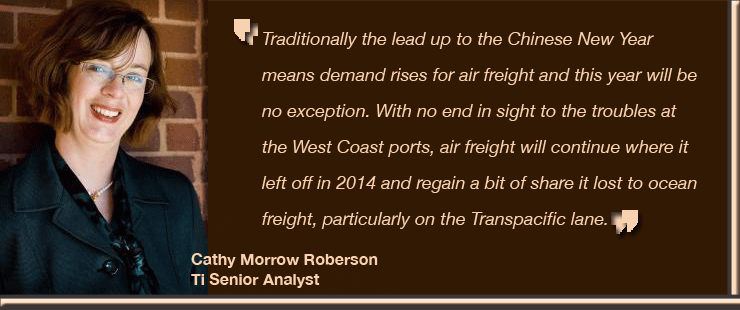
Most signposts
for air freight are looking rather perky ahead of an expected spike in
demand out of China before factories close for Lunar New Year celebrations.
Stifel’s January Airfreight Logistics Confidence
sub-index—which uses a European-based survey to generate its results
and so does not take into account congestion and labor challenges on the
U.S. West Coast—continued on the relatively steady upward curve
that started in March 2014, as it increased 0.8 points compared to December
to reach 56.6.
 All lanes experienced gains in January except U.S. to Europe, which declined
0.4 points to 53.6. Europe to the U.S. was the biggest improver. Aided
by the strong greenback this lane rose 2.6 points to 54.7. Europe to Asia
increased 0.2 points to 47.2 and Asia to Europe gained 0.9 points to reach
an impressive 61.9.
All lanes experienced gains in January except U.S. to Europe, which declined
0.4 points to 53.6. Europe to the U.S. was the biggest improver. Aided
by the strong greenback this lane rose 2.6 points to 54.7. Europe to Asia
increased 0.2 points to 47.2 and Asia to Europe gained 0.9 points to reach
an impressive 61.9.
In Asia the export demand outlook is particularly
robust. Speaking to FlyingTypers from Thailand,
Stewart Sinclair, managing director of Suvarnabhumi Airport ground handler
Bangkok Flight Services, said volumes had been strong throughout 2014
and this had been maintained in early 2015.
“We see no reason for this not to continue into the New Year,”
he said. “There have been some additional charters related to the
West Coast congestion but in general we have seen continued strong volumes
throughout the year.”
The Association of Asia Pacific Airlines said
members had seen an “encouraging revival in demand after three consecutive
years of declines” during 2014 as international shipments from manufacturing
hubs prompted a 5.4 percent year-on-year gain in freight ton kilometer
terms. Andrew Herdman, AAPA director general, said the outlook for the
coming year was “broadly positive.”
 Asian carriers will be major beneficiaries of the anticipated peak out
of China and other hubs in Asia in the coming weeks, as shippers rush
to ship product ahead of the Chinese New Year celebrations.
Asian carriers will be major beneficiaries of the anticipated peak out
of China and other hubs in Asia in the coming weeks, as shippers rush
to ship product ahead of the Chinese New Year celebrations.
These officially run February 18-24, but factories
will be closed before and after this period as coastal workers commence
long journeys back to villages in the interior. A large proportion also
fails to return, and short-term labor shortages are not unusual after
the holidays.
“We expect to see a surge in volumes ex
China over the next two weeks in the run up to Chinese New Year—this
would be in line with previous years,” one Asia-based carrier executive
told FlyingTypers.
“The West Coast is also still playing its
part. Demand to the U.S. is notably stronger than demand to Europe and
we expect this to continue throughout the quarter.
“Even if all the West Coast issues were
solved overnight there would still be a considerable backlog.”
Cathy Roberson, a U.S.-based senior analyst at Transport Intelligence,
takes a similar line.
“Traditionally the lead up to the Chinese New Year means demand
rises for air freight and this year will be no exception,” she said.
“With no end in sight to the troubles at the West Coast ports, air
freight will continue where it left off in 2014 and regain a bit of share
it lost to ocean freight, particularly on the Transpacific lane.”

Stifel’s January Airfreight Logistics Confidence
‘expected situation’ index is also upbeat when looking beyond
the first quarter. A reading of 58.7 for July was taken compared to the
still upbeat 54.5 recorded in January, with confidence high across the
lanes.
However, Drewry is taking a surprisingly bearish
view on rates. The analyst said air freight rates had retreated from their
November high as peak season demand receded.
“Drewry’s East-West Air Freight Price
Index fell 12.6 points in December to 108.2 points, bringing the index
down closer to seasonal norms,” the analyst said in its latest Drewry
Sea & Air Shipper Insight. “This brought to an end six consecutive
months of rising pricing in which the index had gained 21.5 points, to
November’s all-time high of 120.8 points.
“Drewry expects air freight pricing to
fall further in the near term as peak season recedes and lower jet fuel
costs feed into fuel surcharges.”
Sky King
|





